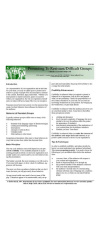Feedback To Dumb As Rocks People
When The People Who NEED The Feedback Are The Least Likely To “Hear” It
It’s an odd world. It seems that the people who really need to hear how they are perceived by others, are also the least likely to hear the feedback, or connect the feedback to specific actions they, themselves involve themselves in.
Before I started my own business, I worked in a department of about fifteen people. There were two employees who were not only the least productive, but also tended to disrupt the work of others, and created an atmosphere of mistrust and for some, fear.
Staff meetings and team building discussions didn’t work. When other employees mentioned issues pertaining to one of the other, in the hope that the “miscreants” would recognize themselves, the conversation would go like this:
Pat: “Well, I hope that we’re all committed to respecting each other’s boundaries and not interrupting the work of others by dropping by unannounced? I know I’m still having people stand outside my office or interrupt me when it’s clear I’m working.
Miscreant: “Absolutely, Pat. I know I’m completely in favor of this, because I hate being interrupted” [unfortunately Miscreant was the primary culprit in hanging around others’ offices or interrupting].
Problem employees, or for that matter, problem people, don’t often have a single flaw that makes them difficult.
Whether one wants to call it emotional intelligence, or interpersonal awareness, the same underlying causes of poor social and work behavior also affect the person’s ability to realize that the feedback, or attempts to hint at a problem, are actually directed at them.
Same On Social Media
It’s the same issue on social media, and in particular, in group discussions. Recently, on BeBee, an emerging social media platform, there were several posts about what seemed to be an emergence of bullying behavior.
No names were mentioned. No specific behaviors were identified, presumably so nobody was singled out publically, or made to feel uncomfortable.
People in the discussions of course, jumped in with supporting comments. After all, who is “for” bullying online. Unfortunately, several of the supporting commentators were also the subject of the articles. They were the specific people who the article authors perceived as bullying and intimidating, yet, even when faced with some “hints”, they didn’t see themselves that way.
They acted as if they saw themselves as the problem-solvers and not the problems.
Basic Principles
It seems there’s two operating principles here.
- That people with the least awareness of other people and their perceptions are the least able to identify that feedback is about them, and that they are perceived negatively.
- Even when direct feedback is offered, those same people will tend to reject, or deny its validity.
The Million Dollar Question: Getting Through
The question, of course, is how do you get through to problem individuals, wherever they roam. Is it even possible?
It may not always BE possible, so once you’ve followed proper feedback procedures, your goal may be to mitigate the damage. In the case with Miscreant, one might have to keep one’s office door shut, and post a sign when working, as something to try.
Still, it’s worth trying the tips that follow
Feedback in a group setting is awkward, not only for the giver but the receiver. The public nature of the group puts the recipient in a resistant mode. Convey feedback privately when possible.
Consider carefully, if private feedback is not practical, whether it might be better to keep one’s mouth shut. There are situations when you just KNOW the individual is going to be so resistant, and so angry at what you have to say, that it’s going to be a major conflagration. Weigh the value of harmony over the value of possibly resolving a problem with that person.
Be specific. Whether it’s on social media, or at work, everyone needs the details of the behaviors that are problematic, and this applies particularly for poor souls who simply are not good at people issues. If it’s verbal behavior, quote it accurately. If it’s written behavior offer the specific instances.
Stick to visible facts, and try to avoid characterizations. Characterizations involve putting a label on the person or the behavior. For example all of the below are characterizations and not facts:
- calling someone a troll, or any other name
- suggesting a person or action is inconsiderate, or once again, any other term of similar type such as disruptive, insulting, etc.
Characterizations say more about you than the do about the person you are trying to get through to.
One Last Thing On Public Feedback
In both the workplace situation and the social media situation, something peculiar happened. The person(s) trying to provide feedback gently and without providing specifics, certainly with the best intention set up a scenario where other participants after reading or hearing the feedback, wondered if the speaker/writer was referring to them.
So, the upshot was that a sense of trust was lost. Was it “I” that was the culprit? was a question that was clearly on some people’s minds. And that’s a shame, because while vagueness and gentleness are sometimes appropriate, and certainly well intentioned at times, they leave the door open for speculation.
Heck, now I’m wondering…was it me?






